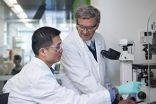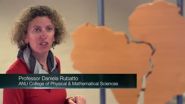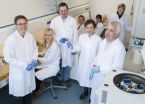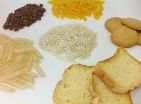(Press-News.org) Melbourne researchers have challenged conventional thinking on how the bowel lining develops and, in the process, suggested a new mechanism for how bowel cancer starts.
The researchers produced evidence that stem cells are responsible for maintaining and regenerating the 'crypts' that are a feature of the bowel lining, and believe these stem cells are involved in bowel cancer development, a controversial finding as scientists are still divided on the stem cells' existence.
Using 3D imaging technologies, Dr Chin Wee Tan and Professor Tony Burgess from the Walter and Eliza Hall Institute showed for the first time the bowel generates new intestinal crypts by a process called 'budding'. The finding overturns the existing theory of how intestinal crypts form, with significant implications for our understanding of bowel cancer development.
Intestinal 'crypts' are pocket-like wells in the bowel wall that produce mucous and absorb nutrients and water. Each day, 300 cells in each crypt die and are replaced. Until now, it was believed new crypts were produced only when existing crypts 'split in half symmetrically' during early development and only regenerated in adults after significant injury.
However Dr Tan said his images showed that wasn't the case. "Using advanced 3D imaging technologies, we generated a complete view of many bowel crypts and their production at many different stages of life," Dr Tan said. "We showed new crypts continue to be produced at a low but detectable rate in adults, not only during early growth, but as a normal part of bowel maintenance."
Dr Tan said the team's findings also challenged the accepted belief on how new crypts were generated. "Our images clearly showed new crypts start from asymmetrical 'buds' that develop at the bottom of the crypt, not by each crypt splitting down the middle."
Dr Tan said the research also uncovered a likely link between crypt 'budding' and bowel cancer. "We showed that as part of normal intestinal development only one bud at a time is generated by each regenerating crypt," he said. "In precancerous and cancerous bowel tumours, we see a lot of out-of-control budding, and many buds associated with a single crypt, suggesting the genes that exert control over the budding process may have been 'lost', initiating bowel cancer development."
Bowel cancer is a leading cause of cancer-related death in the developed world. Professor Burgess said the research findings suggested although 'crypt-generating' stem cells were usually 'quiet' in a healthy bowel, they were likely to be the initiators of bowel cancer.
The critical change that led the stem cells to initiate out-of-control budding was likely related to the APC (adenomatous polyposis coli) gene, Professor Burgess said. "Eighty-five per cent of all bowel cancers have lost APC function, and all have excessive crypt budding," he said. "APC is essential for controlling crypt production and maintaining adhesion between bowel stem cells. Losing APC disturbs control of bowel stem cell location and production, causing 'chaotic' growth of crypt buds and leading directly to precancerous and cancerous growths."
Professor Burgess said the research, combined with recent studies from institute researchers Dr Michael Buchert and Associate Professor Matthias Ernst, provided strong evidence that crypt-generating stem cells were responsible for driving bowel cancer growth.
"It is essential to know whether these stem cells are driving or maintaining cancer development, as they behave very differently to other bowel stem cells," Professor Burgess said. "To target bowel cancer effectively, we need to think differently about how to kill stem cells that have lost the APC gene."
INFORMATION:
The research was supported by the Australian National Health and Medical Research Council and the Victorian Government.
http://www.plosone.org/article/info%3Adoi%2F10.1371%2Fjournal.pone.0078519 END
Cryptic clues drive new theory of bowel cancer development
2014-10-16
ELSE PRESS RELEASES FROM THIS DATE:
Magnetic mirrors enable new technologies by reflecting light in uncanny ways
2014-10-16
WASHINGTON, Oct. 16—As in Alice's journey through the looking-glass to Wonderland, mirrors in the real world can sometimes behave in surprising and unexpected ways, including a new class of mirror that works like no other.
As reported today in The Optical Society's (OSA) new high-impact journal Optica, scientists have demonstrated, for the first time, a new type of mirror that forgoes a familiar shiny metallic surface and instead reflects infrared light by using an unusual magnetic property of a non-metallic metamaterial.
By placing nanoscale antennas at or ...
Scientists find ancient mountains that fed early life
2014-10-16
VIDEO:
Scientists from Australian National University reveal how they found a mountain range that fed an explosion of life 600 million years ago. The range stretched 2,500 km across Gondwana from...
Click here for more information.
Scientists have found evidence for a huge mountain range that sustained an explosion of life on Earth 600 million years ago.
The mountain range was similar in scale to the Himalayas and spanned at least 2,500 kilometres of modern west Africa and northeast ...
Plant communities produce greater yield than monocultures
2014-10-16
Although monocultures can be cultivated efficiently, they are anything but sustainable: environmental damage to soil and water caused by monoculture cultivation is becoming increasingly evident. Despite their disadvantages, however, monocultures remain the principal crop form and are regarded as the sole possibility of achieving higher yields in plant production – quite wrongfully, finds Bernhard Schmid, an ecology professor at the University of Zurich, who advocates a novel form of agriculture and forestry. After all, a new study carried out by PhD student Debra ...
New perspectives for development of an RSV vaccine
2014-10-16
Respiratory Syncytial Virus causes severe respiratory tract infections and worldwide claims the lives of 160,000 children each year. Scientists at VIB and Ghent University have succeeded in developing a promising vaccination strategy to counteract this common virus infection.
Xavier Saelens (VIB/UGent): "We discovered a new vaccination strategy that paves the way for the development of a novel approach to vaccination against RSV, a virus that causes suffering in numerous small children and elderly people."
RSV: an infection that is difficult to combat
The Respiratory ...
Mild traumatic brain injury can have lasting effects for families, reports the American Journal of Nursing
2014-10-16
October 16, 2014 – Families of patients with mild traumatic brain injury (TBI) may expect them to return to normal quickly—after all, it's "just a concussion." But mild TBI can have a lasting impact on families as well as patients, according to a review in the November issue of American Journal of Nursing. The journal is published by Lippincott Williams & Wilkins, a part of Wolters Kluwer Health.
"With the increasing numbers of people with mild TBI in the community, it's crucial for nurses to make this a part of assessment for early recognition and intervention," ...
Energy prices and business decision-making in Canada: Preparing for the energy future
2014-10-16
A new expert panel report, Energy Prices and Business Decision-Making in Canada: Preparing for the Energy Future, released today by the Council of Canadian Academies, details how Canadian businesses have historically been successful in responding to fluctuating energy prices, but this should not be considered a predictor for future resiliency or competiveness. The energy environment is evolving with advances in oil and gas extraction, the development of alternative energy sources, changes within the electricity market, and new regulatory requirements. Understanding the ...
The social web of things
2014-10-16
Research to be published in the International Journal of Web-Based Communities suggests that the familiar interfaces of online social networking sites might be adapted to allow us to interact more efficiently with our networked devices such as cars, domestic appliances and gadgets. The concept would also extend to the idea of those devices connecting with each other as necessary to improve efficiency of heating and lighting, make our home entertainment systems smarter and much more.
Are you Facebook friends with your microwave oven, is your car? Does your washing machine ...
Informative visit to the toilet
2014-10-16
Emily loves Justin - Stop global warming - Two more weeks till I graduate!: The exchange of information in public toilets is widespread. It also occurs in the world of white-footed sportive lemurs. Only instead of writing on the walls, they use scent-marks in order to communicate with their own kind. In a study published online in Springer's journal Behavioral Ecology and Sociobiology, Iris Dröscher and Peter Kappeler from the German Primate Center (DPZ) have found that the urine left on latrine trees serves as a method to maintain contact with family members. It also ...
Adenosine can melt 'love handles'
2014-10-16
The number of overweight persons is greatly increasing worldwide - and as a result is the risk of suffering a heart attack, stroke, diabetes or Alzheimer's disease. For this reason, many people dream of an efficient method for losing weight. An international team of researchers led by Professor Alexander Pfeifer from the University Hospital Bonn, have now come one step closer to this goal. The scientists discovered a new way to stimulate brown fat and thus burn energy from food: The body's own adenosine activates brown fat and "browns" white fat. The results are now being ...
Some rice-based foods for people with celiac disease contain relevant amounts of arsenic
2014-10-16
Rice is one of the few cereal grains consumed by people with celiac disease, as it does not contain gluten. However, it can have high concentrations of a toxic substance – arsenic – as revealed by the analyses of flour, cakes, bread, pasta and other foods made with rice, conducted by researchers from the Miguel Hernández University of Elche, Spain. The European Union is working to establish the maximum quantities of arsenic in these products.
Celiac disease affects almost 1% of the population of the western world, a group which cannot tolerate gluten ...





